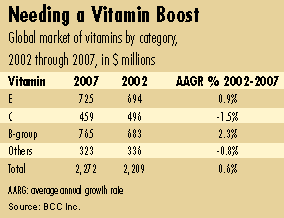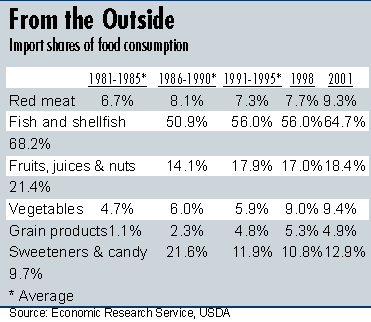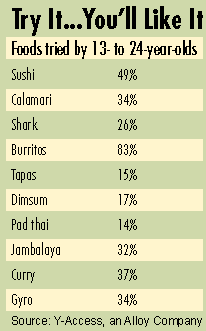
Taking Vitamins
In an update to “The Global Market for Vitamins in Food, Feed, Pharma and Cosmetics,” Business Communications Company Inc. (BCC) offers an assessment of the vitamin industry in the wake of major developments surrounding the global vitamin market. The food and, to a degree, the supplement areas remain a source of strong sales, due to the popularity of new food concepts and volume growth in food nutrition. However, BCC notes the reduction in price levels for most vitamins due to market entry by Chinese companies.This has led to a number of changes in the U.S. market, including a number of acquisitions/mergers and some demises. DSM (Heerland, the Netherlands) purchased Roche Group (Basel, Switzerland), and BASF (Ludwigshafen, Germany) took over the Takeda (Lincolnshire, Ill.) vitamin business. Rhone-Poulenc broke up, while new vitamin- and feed-ingredient company Adisseo (Alpharetta, Ga.) was formed.
Leading this drastically altered market is Roche/DSM, with 27% share of the global vitamin business, followed by the 21% share held by BASF. As a whole, Chinese producers maintain a strong 24%, but BCC notes that this share is split among many small companies.

Feed leads the way as an outlet for vitamins, holding a commanding market share of nearly 50%. Supplements are a distant second, with 22%, followed by the food segment's 17%. Among the vitamins themselves, E, C and A accounted for more than 65% of sales in 2002.
Expecting market developments for vitamins to be less dramatic than in the recent past, BCC predicts prices for most vitamins will not fall much further, while consumption “especially in food and feed might increase.” Nonetheless, the market is not likely to grow much beyond its current level. BCC estimates the market will rise only $2.3 billion through 2007, with an average annual growth rate of less than 1%.
For more information on the report, contact BCC at 203-853-4266, ext. 309, or e-mail: publisher@bccresearch.com.

Emerging Import-ance
The USDA (Washington) has compiled a look at the import share of U.S. food consumption. It defines import share of a food product as the ratio of its imported volume to total volume consumed. The average share of imports in U.S. food consumption reached 11% in 2000, up from 8% in the early 1980s. Of course, U.S. consumption of all foods grew from an average 1,800 pounds per year in the early 1980s to more than 2,000 pounds in 2000.The average U.S. consumer enjoyed 20% more fruits, vegetables and cereals over that time frame, though their consumption of animal products grew only 7%. In 2001, the U.S. import share of consumption of animal products stood at 4.6%, with a 16% import share for crops and products, up from 3.4% and 10%, respectively, in the early 1980s.
U.S. per capita consumption of red meat dropped from more than 9% in the 1980s to less than 8% in recent years. During the same period, consumption of dairy products fell to 28% from 30%.
“Clearly,” the USDA observed, “the perceived health-related benefits of more plant fiber and less animal fat in diets shaped the pattern of U.S. food consumption.” Consumption share of vegetables grew to 21% from 19%, and grain cereals jumped to 9.5% from 8%.

A strong U.S. economy and dollar helped to drive the growth in import share, but other influences also impacted certain sectors. For instance, while red meat import share grew to 9%, the USDA recalled a widespread liquidation of the U.S. cattle herd, which cut the domestic supply of processing beef. Furthermore, the economic recession in many Asian countries “diverted Australian and New Zealand meat to the U.S. market.”
For more information on the USDA report, visit www.ers.usda.gov.

Y Now!
The perception persists of Generation Y/Millennials as a cynical, apolitical, individualistic bunch of pierced skateboarders, similar to their Generation X predecessors. Armed with this notion, marketers attempt to reach them through hip, edgy statements pushing the boundaries of style and taste. While the Y group may be edgy, a pair of studies made some interesting observations.The University of Michigan's Institute for Social Research (Lansing, Mich.) reported that smoking, drinking and drug use among 8th, 10th and 12th graders fell simultaneously in 2002 for the first time.
Kids are less likely to trust music celebrities (35%) and athletes (30%), instead relying on their parents (86%), teachers (86%) and the police (83%), according to Applied Research & Consulting LLC (New York).
Pete Markiewicz, Ph.D. and author of Millenials and Entertainment suggests defining a new “Millennial” generation as those born between the 1980s and 2000 or 2001. Note several differences between Millennials and the fading notions of Generation X.
The majority of Millennials identify parents as their heroes, and parents and the child commonly decide purchases together. Those who try to appeal to this group with notions of rebellion are likely to fail.
Parents of Millennials are found on school campuses, and their influence can be seen in recent school board decisions to omit soft drinks and other vending items from school cafeterias.
Celebrity role models and their associated brands have less of an effect on Millenials, who opt instead to trust family, religion and community.
Brands, therefore, that use celebrities with edgy messaging may not reach this “increasingly conventional generation, which looks for social consensus instead of pushing the limits of taste,” believes Markiewicz.
Millennials have little in common with the Generation X slacker. Markiewicz advises, “Advertising lampooning hard work and celebrating the accidental success of airheads does not speak to this generation.”
While the X crowd is regarded as ultra-individualist, Millennials are perceived as more group-oriented and, therefore, less interested in becoming an “army of one.”

Millennials in America also are facing a very different world from their predecessors. September 11, the wars in Iraq and Afghanistan, SARS, anthrax and incidents of domestic terrorism will have untold impact upon this group. Consumer analyst Marcia Mogelonsky (Utica, N.Y.) believes this will make them much more suspicious.
Furthermore, Mogelonsky notes the media-saturated environment of today's youth. Constant communication via cellular technology and the Internet will affect the perceptions of this group. Considering recent ventures into advertising in new venues (constant ads on the Internet, a well-known hamburger giant's placement in The Sims video game, the possibilities inherent in advertising through PDAs and handheld games, etc.), making an impact with the Millennial crowd will require considerable effort and forethought to stand out from the crowd. Mogelonsky notes, “A lot of children spend time on the web and games as well. Nothing grabs their attention like video games. If only manufacturers could find a way to advertise snack food on the Game Boy…”
Sidebar: THE IN BOX
John Ruff, senior vice president of R&D, and Jean E. Spence, vice president of worldwide quality, scientific affairs and compliance, will trade job assignments at Kraft Foods North America (Northfield, Ill.). In addition, Kraft Foods International announced the retirement of Ronald J.S. Bell, president of its European Union Region. As a result, the company has reorganized its European Union Region into two geographic units—Western Europe and West Central Europe. Brain M. Carlisle will be president of the Western Europe region, while Joachim Krawczyk is president of the West Central Europe Region. Furthermore, Gustavo H. Abelenda has been appointed president of the company's Latin America region. Proliant Inc. (Ames, Iowa) has promoted Angie Strotman to marketing manager of the company's health division.Eurofins Scientific (Augsburg, Germany) has acquired a majority ownership (68.3%) of GeneScan Ag (Germany), and as a result, GeneScan USA (New Orleans) has become part of the Eurofins group in the United States.
Farbest Brands (Montvale, N.J.) has formed an exclusive business relationship with Alland and Robert (Paris).
Coffee Enterprises appointed Michael Page as vice president of sales for the company's Extract and Ingredients division.
North Coast Processing Inc. (North East, Pa.) appointed Mike Hackbarth as director of business development and marketing
PMS Foods LP (Hutchinson, Kan.) has changed its name to Legacy Foods LLC.
Owens Country Sausage (Richardson, Texas) named Mike Townsley president and chief operating officer.
Brown-Forman Beverages (Louisville, Ky.) appointed Mark McCallum to chief marketing officer of the company's spirits brands.
Smithfield Foods (Smithfield, Va.) acquired Global Culinary Solutions Inc. and formed the Smithfield Innovation Group to develop new products for customers in retail, club store, and foodservice channels. Additionally, Smithfield agreed to purchase “substantially all of the assets and certain liabilities” of Farmlands Foods.
Tyson Foods (Springdale, Ark.) will consolidate operations in its Pine Bluffs, Ark., facilities. The company also has appointed Kevin J. Igli to the newly created position of chief environmental officer.
Cargill (Minneapolis) and Riceland Foods (Stuttgart, Ark.) announced their intention to form a strategic alliance to manufacture, market and sell lecithin products to food, pharmaceutical and technical customers worldwide.
Fortitech Inc. (Schenectady, N.Y.) announced that Mae Ng has joined Fortitech Asia Pacific as general manager. The company also acquired the nutritional premix blending business of Ashland Distribution Company (Covington, Ky.).
Humko Oil Products (Memphis, Tenn.) has added a new flake production system in their Jacksonville, Ill., manufacturing facility beginning July 2003.
Ted Benic has been named director of Field Technical Services with TIC Gums (Belcamp, Md.). In addition, Maureen Akins has joined TIC Gums as a food technologist.
PTX Food Corp. (Cortland Manor, N.Y.) announces the approaching completion of its new “State of the Art” 30,000-sq.ft. fermentation facility and research center. The newly constructed plant is located in the Riverport Industrial and Foreign Trade Zone of Louisville, Ky. The new plant has been expanded for an immediate increase of five times its present capacity, with ample room for additional continued growth.
The J.R. Simplot Company (Boise, Id.) opened a new French-fry plant in Portage la Prairie, Manitoba, Canada. Projected to produce more than 300 million pounds of fries primarily for restaurant chains, the plant has the capacity to double in size.
Deborah McIntyre has been named laboratory manager of rtech laboratories/Land O'Lakes Inc. (Arden Hills, Minn.).
The FDA (Washington) has eliminated the label requirement for packages of snack foods made with Procter & Gamble's (Cincinnati) Olean brand fat replacer.
Bunge Limited (White Plains, N.Y.) appointed Hunter C. Smith as regional chief financial officer - Asia, and Susanna Ter-Jung as director of investor relations and global communications.